Which of the following causes the seasons of the earth?
The tilt of the axis of the earth
2) Which of the following chordate groups has all four key chordate characteristics as an adult?
Lancelets
3) Polar regions are cooler than the equator because
The poles are farther from the sun
4) Why is the amniotic egg considered an important evolutionary breakthrough?
It allows deposition of eggs in a terrestrial environment
5) Which of the following levels of organization is arranged in the correct sequence from most to least inclusive?
Ecosystem,community,population,individual
6) Which type of biome would most likely occur in a climate with seasonal precipitation, rainy winters are hot, dry summers (daytime temperature can exceed 40 degrees C)?
Chaparral
7) Which of the following are important biotic factors that can affect the structure and organization of biological communities?
predation, competition
8) Which of the following includes two major clades of living vertebrates?
Cyclostomes and Gnathostomes
9) In the process of energy transfer between trophic levels, the percentage of energy stored in assimilated foods that is not used for respiration, is known as
Production efficiency
10) Which one of the following would contribute the most to the removal of CO2 from the atmosphere in the carbon cycle?
Photosynthetic organisms
11) A cow’s herbivorous diet indicates that itis a(n)
Primary consumer
12) An ecologist recorded 12 white-tailed deer, Odocoileus virginianus, per square mile in one woodlot and 20 per square mile on another woodlot. What was the ecologist comparing?
density
13) What is the most important role of photosynthetic organisms in an ecosystem?
converting inorganic compounds into organic compounds
14) A new species of aquatic chordate is discovered that closely resembles an ancient form. It has the following characteristics: external armor of bony plates, no paired lateral fins, and a suspension-feeding mode of nutrition. In addition to these, it will probably have which of the following characteristics?
no jaws
15) which of the following biotic factors would have the greatest impact in limiting the ability of organisms to survive and reproduce?
Disease
16) The high level of pesticides in birds of prey is an example of
Biological magnification
17) In 2008, the population of New Zealand was approximately 4,275,000 people. If the birth rate was 14 births for every 1,000 people, approximately how many births occurred in New Zealand in 2008?
60,000
18) The animal diversity in this terrestrial biome is higher than in any other biome
Tropical forest
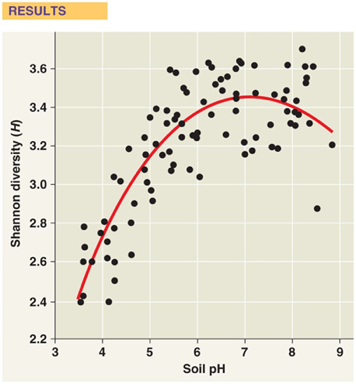
19) This graph shows the effect of soil pH on microbial diversity. One conclusion you should draw from this figure is:
there appears to be an optimal pH value for maximizing microbial diversity
20) Which of the following causes an increase in the intensity of UV radiation reaching the Earth?
Depletion of atmospheric zone
21) With which of the following statements would an evolutionary biologist be most inclined to agree?
Humans and apes represent divergent lines of evolution from a common ancestor
22) Which of the following biomes is correctly paired with the description of its climate?
tropical forests–nearly constant day length and temperature
23) Trees are not usually found in the tundra biome because of
permafrost.
24) Carrying capacity is
the maximum population size that a particular environment can support.
25) Which of these are amniotes?
- A) amphibians
- B) fishes
- C) egg-laying mammals
- D) placental mammals
More than one of these is correct.
26) Consider the food chain grass → grasshopper → mouse → snake → hawk. How much of the chemical energy fixed by photosynthesis of the grass (100%) is available to the hawk?
0.01%
27) The common spiny mouse (Acomys cahirinus) and the golden spiny mouse (A. russatus) can occupy essentially the same ecological niche. They accomplish this by:
temporal niche partitioning
28) Which of these ecosystems has the lowest net primary production per square meter?
a grassland
29) The major role of detritivores in ecosystems is to
recycle chemical nutrients to a form capable of being used by autotrophs
30) The are of ecology concerned with the behavioral, physiological, and morphological ways individuals interact with the environment is known as
Organismal ecology
31)Which of the following is an example of cryptic coloration?
a "walking stick" insect that resembles a twig
32) Evidence shows that some grasses benefit from being grazed. Which of the following terms would best describe this plant-herbivore interaction?
mutualism
33) Monarch butterflies are protected from birds and other predators because of cardiac glycosides they incorporate into their tissues from eating milkweed when they were in their caterpillar stage. The wings of a different species of butterfly, the Viceroy, look nearly identical to the Monarch so predators that have learned not to eat the bad-tasting Monarch avoid Viceroys as well. This example best describes
Batesian mimicry
34) To measure the population of lake trout in a 250-hectare lake, 400 individual trout were netted and marked with a fin clip, then returned to the lake. The next week, the lake was netted again, and out of the 200 lake trout that were caught, 50 had fin clips. Using the capture-recapture estimate, the lake trout population size could be closest to which of the following?
1,600
35) Arrange these taxonomic terms from most inclusive (most general) to least inclusive (most specific)
- Amphibians Gnathostomes 3. Osteichthyans 4.Tetrapods 5. Vertebrates
5,2,3,4,1
36) Given that, in the process of energy transfer between trophic levels, trophic efficiencies are generally about 10%. What percent of the energy fixed by primary producers in a typical field ecosystem, would a secondary consumer (such as fox) receive?
1%
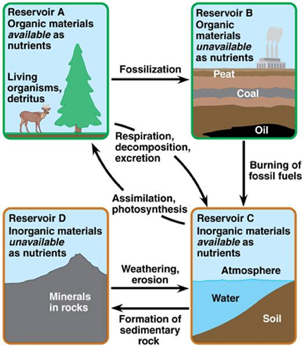
37) Look at the diagram, which shows a general model of nutrient cycling. There are major differences between kingdoms of organisms; for example, plants tend to do most assimilation and photosynthesis. However, all living things contribute to one of the arrows on this diagram. Which arrow shows an activity or activities that is/are performed by every living thing?
respiration, decomposition, and excretion
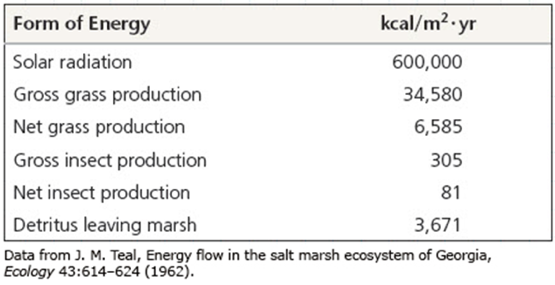
Teal measured the amount of solar radiation entering a salt marsh in Georgia over a year. He also measured the aboveground biomass of the dominant primary producers, which were grasses, as well as the biomass of the dominant consumers, including insects, spiders, and crabs, and of the detritus that flowed out of the marsh to the surrounding coastal waters. To determine the amount of energy in each unit of biomass, he dried the biomass, burned it in a calorimeter, and measured the amount of heat produced. (for questions 45-50)
How much energy is lost by primary producers as respiration in this ecosystem?
27,995 kcal/m^2 * yr
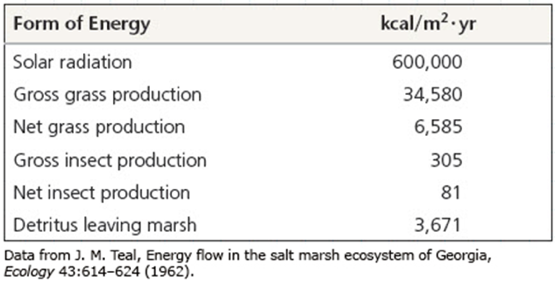
Teal measured the amount of solar radiation entering a salt marsh in Georgia over a year. He also measured the aboveground biomass of the dominant primary producers, which were grasses, as well as the biomass of the dominant consumers, including insects, spiders, and crabs, and of the detritus that flowed out of the marsh to the surrounding coastal waters. To determine the amount of energy in each unit of biomass, he dried the biomass, burned it in a calorimeter, and measured the amount of heat produced. (for questions 45-50)
How much energy is lost by primary producers as respiration in this ecosystem?
224 kcal/m2 • yr
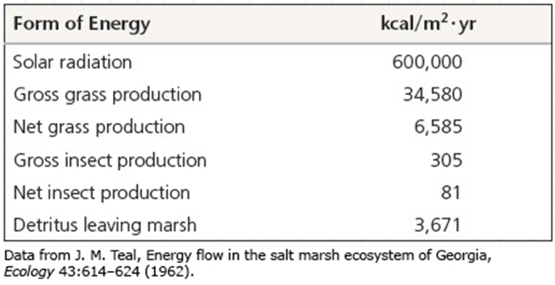
Teal measured the amount of solar radiation entering a salt marsh in Georgia over a year. He also measured the aboveground biomass of the dominant primary producers, which were grasses, as well as the biomass of the dominant consumers, including insects, spiders, and crabs, and of the detritus that flowed out of the marsh to the surrounding coastal waters. To determine the amount of energy in each unit of biomass, he dried the biomass, burned it in a calorimeter, and measured the amount of heat produced. (for questions 45-50)
Using the table above, how would you describe the population dynamics of L. vivipara?
The population is increasing
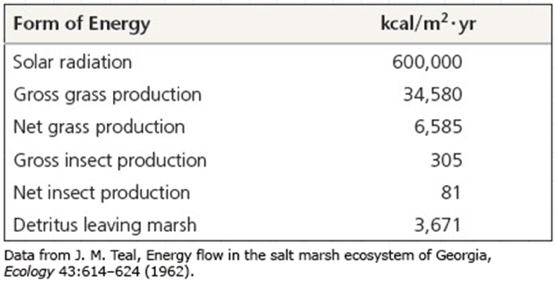
Teal measured the amount of solar radiation entering a salt marsh in Georgia over a year. He also measured the aboveground biomass of the dominant primary producers, which were grasses, as well as the biomass of the dominant consumers, including insects, spiders, and crabs, and of the detritus that flowed out of the marsh to the surrounding coastal waters. To determine the amount of energy in each unit of biomass, he dried the biomass, burned it in a calorimeter, and measured the amount of heat produced. (for questions 45-50)
What percentage of the solar energy that reaches the marsh is incorporated into net primary production?
1.1%
Teal measured the amount of solar radiation entering a salt marsh in Georgia over a year. He also measured the aboveground biomass of the dominant primary producers, which were grasses, as well as the biomass of the dominant consumers, including insects, spiders, and crabs, and of the detritus that flowed out of the marsh to the surrounding coastal waters. To determine the amount of energy in each unit of biomass, he dried the biomass, burned it in a calorimeter, and measured the amount of heat produced. (for questions 45-50)
What percentage of the solar energy that reaches the marsh is incorporated into gross primary production?
5.8 %
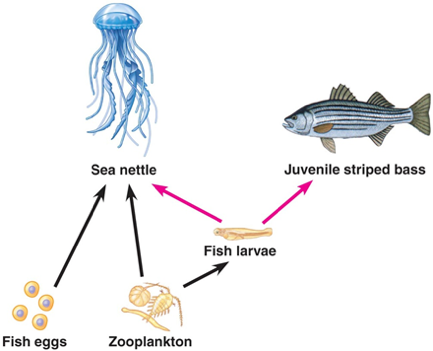
43) Look at the following figure (Figure 54.13 in the textbook), which shows a partial Chesapeake Bay food web. If sea nettles disappeared, this figure predicts that
there would be more striped bass
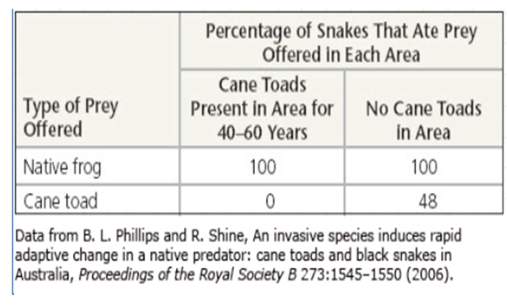
In the first part of an experiment, researchers collected 12 black snakes (Pseudechis porphyriacus) from areas where cane toads had existed for 40–60 years and another 12 from areas free of cane toads. They offered the snakes either a freshly killed native frog (Limnodynastes peronii, a species the snakes commonly eat) or a freshly killed cane toad from which the toxin gland had been removed (making the toad nonpoisonous).
What do the data suggest about the effects of cane toads on the predatory behavior of black snakes in areas where the toads have been present for 40–60 years?
Black snakes will not prey on cane toads in areas where cane toads have been present for 40–60 years.
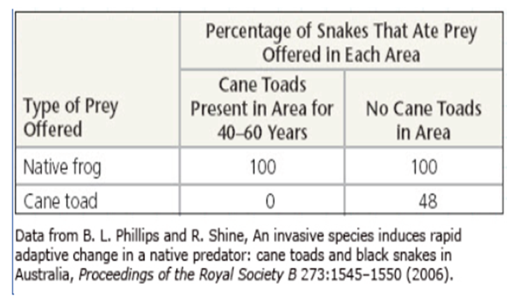
In the first part of an experiment, researchers collected 12 black snakes (Pseudechis porphyriacus) from areas where cane toads had existed for 40–60 years and another 12 from areas free of cane toads. They offered the snakes either a freshly killed native frog (Limnodynastes peronii, a species the snakes commonly eat) or a freshly killed cane toad from which the toxin gland had been removed (making the toad nonpoisonous).
What do the data suggest about the predatory behavior of black snakes in areas where cane toads are not currently found?
In those areas, black snakes will prey on cane toads, but they are more likely to prey on native frogs.
46) Mammals and birds eat more often than reptiles. Which of the following traits shared by mammals and birds best explains this habit?
endothermy
47) Which of the following statements is consistent with the principle of competitive exclusion?
Even a slight reproductive advantage will eventually lead to the elimination of the less well adapted of two competing species
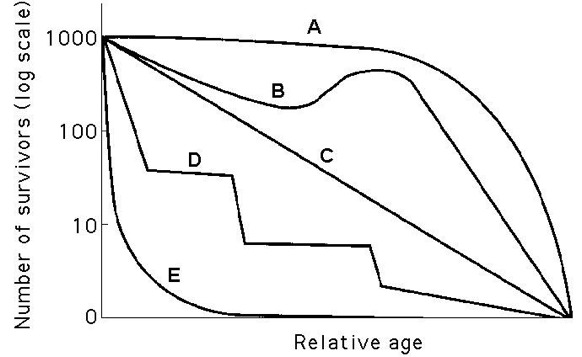
48) Which statement best explains survivorship curve B?
Survivorship can only decrease; therefore, this curve could not happen in nature
49) If the sun were to suddenly stop providing energy to Earth, most ecosystems would vanish. Which of the following ecosystems would likely survive the longest after this hypothetical disaster?
benthic ocean
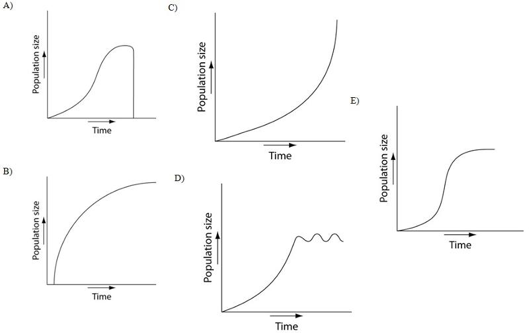
50) Which of the following graphs best illustrates the growth curve of a small population of rodents that has increased to a static carrying capacity.
E